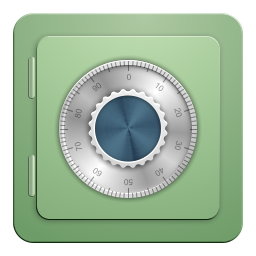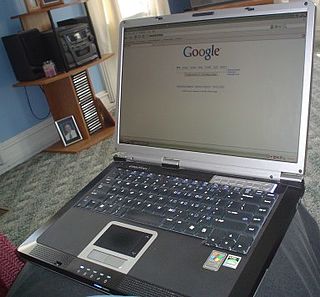The Encrypting File System (EFS) on Microsoft Windows is a feature introduced in version 3.0 of NTFS that provides filesystem-level encryption. The technology enables files to be transparently encrypted to protect confidential data from attackers with physical access to the computer.

TrueCrypt is a discontinued source-available freeware utility used for on-the-fly encryption (OTFE). It can create a virtual encrypted disk within a file, or encrypt a partition or the whole storage device.
Data security means protecting digital data, such as those in a database, from destructive forces and from the unwanted actions of unauthorized users, such as a cyberattack or a data breach.
Disk encryption software is a computer security software that protects the confidentiality of data stored on computer media by using disk encryption.
In computing, data recovery is a process of retrieving deleted, inaccessible, lost, corrupted, damaged, or formatted data from secondary storage, removable media or files, when the data stored in them cannot be accessed in a usual way. The data is most often salvaged from storage media such as internal or external hard disk drives (HDDs), solid-state drives (SSDs), USB flash drives, magnetic tapes, CDs, DVDs, RAID subsystems, and other electronic devices. Recovery may be required due to physical damage to the storage devices or logical damage to the file system that prevents it from being mounted by the host operating system (OS).
Encryption software is software that uses cryptography to prevent unauthorized access to digital information. Cryptography is used to protect digital information on computers as well as the digital information that is sent to other computers over the Internet.

BitLocker is a full volume encryption feature included with Microsoft Windows versions starting with Windows Vista. It is designed to protect data by providing encryption for entire volumes. By default, it uses the Advanced Encryption Standard (AES) algorithm in cipher block chaining (CBC) or "xor–encrypt–xor (XEX)-based Tweaked codebook mode with ciphertext Stealing" (XTS) mode with a 128-bit or 256-bit key. CBC is not used over the whole disk; it is applied to each individual sector.
The Linux Unified Key Setup (LUKS) is a disk encryption specification created by Clemens Fruhwirth in 2004 and originally intended for Linux.
Disk encryption is a technology which protects information by converting it into code that cannot be deciphered easily by unauthorized people or processes. Disk encryption uses disk encryption software or hardware to encrypt every bit of data that goes on a disk or disk volume. It is used to prevent unauthorized access to data storage.

BestCrypt, developed by Jetico, is a commercial disk encryption app available for Windows, Linux, macOS and Android.
This is a technical feature comparison of different disk encryption software.

Private Disk is a disk encryption application for the Microsoft Windows operating system, developed by Dekart SRL. It works by creating a virtual drive, the contents of which is encrypted on-the-fly; other software can use the drive as if it were a usual one.
In computer security, a cold boot attack is a type of side channel attack in which an attacker with physical access to a computer performs a memory dump of a computer's random-access memory (RAM) by performing a hard reset of the target machine. Typically, cold boot attacks are used for retrieving encryption keys from a running operating system for malicious or criminal investigative reasons. The attack relies on the data remanence property of DRAM and SRAM to retrieve memory contents that remain readable in the seconds to minutes following a power switch-off.
Pre-boot authentication (PBA) or power-on authentication (POA) serves as an extension of the BIOS, UEFI or boot firmware and guarantees a secure, tamper-proof environment external to the operating system as a trusted authentication layer. The PBA prevents anything being read from the hard disk such as the operating system until the user has confirmed they have the correct password or other credentials including multi-factor authentication.
Data erasure is a software-based method of data sanitization that aims to completely destroy all electronic data residing on a hard disk drive or other digital media by overwriting data onto all sectors of the device in an irreversible process. By overwriting the data on the storage device, the data is rendered irrecoverable.
The Opal Storage Specification is a set of specifications for features of data storage devices that enhance their security. For example, it defines a way of encrypting the stored data so that an unauthorized person who gains possession of the device cannot see the data. That is, it is a specification for self-encrypting drives (SED).

VeraCrypt is a free and open-source utility for on-the-fly encryption (OTFE). The software can create a virtual encrypted disk that works just like a regular disk but within a file. It can also encrypt a partition or the entire storage device with pre-boot authentication.
Rombertik is spyware designed to steal confidential information from targets using Internet Explorer, Firefox, or Chrome running on Windows computers. It was first publicized by researchers at Cisco Talos Security and Intelligence Group.
Crypto-shredding is the practice of 'deleting' data by deliberately deleting or overwriting the encryption keys. This requires that the data have been encrypted. Data may be considered to exist in three states: data at rest, data in transit and data in use. General data security principles, such as in the CIA triad of confidentiality, integrity, and availability, require that all three states must be adequately protected.

An evil maid attack is an attack on an unattended device, in which an attacker with physical access alters it in some undetectable way so that they can later access the device, or the data on it.





